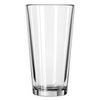Glassware Flashcards
Recommended for Irish stouts such as Guinness.
English tulip pint

Glass that originally became popular for brandy, but is ideal for strong ales. It allows full contact with the hand, warming the glass as it’s held. It concentrates the aroma at the nose and is appropriately small for high ABV beer.
Snifter

This “v” shaped glass has a narrow shape that shows off the beer’s pale color (a big deal when pale beers first appeared!). The outward taper supports the head, the foot is elegant, and they have an art deco look because they became popular in the 1930s.
Tapered pilsner glass

The tall and curvy glass commonly used for hefeweizen and other wheat beers. The large size holds lots of foam.
Vase glass

A short round mug used for English session beers such as milds and bitters. The cut lens design plays with the light and color of the beer. The handle keeps you from warming the beer with your hand.
English dimpled pint

The typical American pint glass.
Shaker pint

The typical British pint glass with the bubbled out section under the rim that makes them easy to stack, prevents chipping of the mouth, and provides for a better grip.
Nonic imperial pint

The glass commonly associated with Belgian specialty beer. The inward taper holds the beer’s aroma, while the outward taper at the top supports the head and makes it easy to drink from.
Stemmed tulip

This is fairly typical goblet glass not unlike a snifter. Similarly, it is appropriate for strong beers and concentrates aroma thanks to its inward taper. It is famous in Antwerp, Belgium and often has a small ball on the stem.
Bolleke Goblet

This is a small glass with a short stem and straight tapered sides. It is classic for bocks.
Pokal glass

Bavarian Seidel
The large tall dimpled German mug perfect for low alcohol German session beers such as Pilsners, Helles, or Oktoberfest. They are essentially a glass copy of large ancient stone mugs that were used for centuries.


English tulip pint

Snifter

Stemmed tulip

Bolleke Goblet

English dimpled pint

Tapered pilsner glass

Pokal glass

Nonic imperial pint

Shaker pint

Vase glass

Bavarian Seidel


